
- Licensing deals must have several ingredients to get the perfect, consumer-approved recipe, including films and products that resonate with consumers.
- Studios expect makeup brand owners to bring quality and inspiration to the table, and deliver products that will sell.
- As 3D goes mainstream, expect to see versions of makeup that transcend high-definition and Blu-ray quality.
The world has swooned over Audrey Hepburn’s Givenchy outfits in Breakfast at Tiffany’s and emulated Marilyn Monroe’s halter dress in Some Like it Hot to the point where these outfits have become iconic themselves. Indeed, the silver screen’s merchandising children have always been in the fashion industry.
But makeup is playing catch-up to this trend of movie licensing, especially since a number of recent movies have spawned a cult following not unlike the fervor generated by the Beatles. The celebrated movie Twilight, for example, grossed $70.55 million during its opening weekend, and its sequel, New Moon, set an opening day box office record with $72.7 million in ticket sales. The movie not only created long lines and anxious teens, tweens and adults alike waiting to get their hands on tickets, but gave them inspiration to recreate a world where pale lips and ghostly skin was as sexy as Brigitte Bardot.
America has always loved its licensing opportunities. From video games to kids’ collectibles from movies such as Toy Story, any in the Harry Potter series, and the upcoming Iron Man 2, merchandising and licensing have been extremely profitable ventures for studios because of the strong impact they’ve had to their revenues. Licensing is basically a win-win for the studio and the manufacturers—for entertainment properties, licensors generally get an up-front guarantee from a master toy licensee, and the studio typically gets a 10–15% cut of wholesale receipts. But here too, there is danger for a hit or miss. If the movie generates blockbuster sales and generates hype, then the pressure is on for the licensees to deliver. If the products fall short of expectations, then the sales suffer.
The NPD Group noted licensed toys in 2009 were a cool 25% (or $5.4 billion) of the total industry sales of $21.5 billion. Although this number represents a slight contraction from the 2008 figures (27% of the $21.65 billion), it still indicates how much fatter sales can be when licensing plays a role in the puzzle.
The leap from licensing toys to licensing makeup is not a hard one to make, especially since women from all over the world have been trying to look like Sophia Loren and Grace Kelly ever since these gorgeous goddesses hit the silver screen. So when makeup companies like Twilight Beauty marketed palettes to recreate the Bella Swan look with its Luna Twilight Just Bitten staining balm, Twilight Venom and Immortal Liquid Body Shimmer, the industry sat up and took notice.
Bath & Body Works was also quick to jump on the Twilight craze, introducing three movie-inspired products just as brooding vampires started to win the hearts of America and the world. Its offerings included the DuWop Twilight Lip Venom, Twilight Woods Body Lotion and a Twilight Woods candle.
In fact, when Twilight hit the theaters in late 2008, sales of pale foundation soared, sending worshippers of traditional bronzers and self-tanners hiding for cover under porcelain skin. According to the online beauty shop FeelUnique.com, sales of pale makeup rose by 200% in October 2009, just when New Moon started to hit theaters. Their best selling product? A fine and pale pink illuminating powder by Bare Escentuals called Mineral Veil.
Makeup Takes Center Stage
Of late, makeup brands have embraced movies and tapped into their blockbuster potential. Hits like Avatar and Tim Burton’s Alice in Wonderland have spawned makeup confections by Milani, Avon, OPI and Urban Decay, to name a few, and the products are already flying off the shelves as though they were collectibles.
Disney Consumer Products approached Urban Decay and OPI to create makeup products inspired by the Alice in Wonderland movie, and the result was magical. Urban Decay’s Alice In Wonderland Book of Shadows makeup palette is like a treasure chest.* When you open the lid, you see a marvelous pop up of Alice gazing at a field of mushrooms. This childlike artistic rendering frames a handy mirror. The 16, richly pigmented eye shadows are all named after characters or places in Alice in Wonderland (from White Rabbit to Curioser).
“The shades we chose for the Alice Palette were inspired by both the outdoor natural world that Alice explores along with by the surreal elements that pop up throughout the story,” says Wende Zomnir, Urban Decay’s creative director and co-founder. Urban Decay ended up with a palette that balanced beautiful neutral tones with bright pops of color. A few colors were directly inspired by characters in the film—the blue Alice shade, for example, was inspired by the blue of Alice’s dress; Absolem, the name of the caterpillar, is a cool iridescent green shade; Chessur, the Cheshire cat, is a distinctively feline shade. The tempting titles and shades cement the consumer interest. OPI created a four-SKU collection of shimmering nail lacquers: Absolutely Alice, a blue glitter; Thanks So Muchness, a red shimmer; Off With Her Red, a vivid red, and Mad as a Hatter, a black multiglitter shade.
Avatar, which has become the highest grossing film of all time, has led makeup companies such as Milani Cosmetics to launch an eponymous line. The result is a 3D makeup line that includes a nail polish, a lip gloss and eye shadow, all of which will have 3D effects through holographic and light-reflecting properties. And, naturally, the shades will predominantly be blue to reflect the glowing, iridescent colors of the movie’s Na’vi tribe.
Avon, too, tapped into Avatar actress Zoe Saldana (who played Na’vi princess Neytiri) as the face of its new fragrance, Eternal Magic, in which the rare Princess Monaco Rose is the key note.
The Future of Makeup Licensing
Suffice to say, the surface of the movie and makeup marriage has just barely been scratched. As 3D goes mainstream, expect to see versions of makeup that transcend high-definition and Blu-ray quality. As movies become increasingly more graphic-rich and intensely pigmented, it’s natural to see these colors acquire a life of their own and become packaged in paint pots, eye shadows and lipsticks.
There is a history of runway to reality; now it’s the time for the silver screen to inspire the makeup bag. But licensing deals, as noted, need to have several ingredients to get the perfect, consumer-approved recipe. First, the quality of the movie has to be inspirational and award-worthy. For instance, no consumer would want to wear makeup products based on the films of Ed Wood, the infamous B-movie director.
Second, the licensing deal has to make sense for both the studio and the makeup company. There are many ways that these two parties can go about making licensing agreements; the licensee will typically pay the licensor a fee to use the trademarked images from the movie, and will also pay royalties from the product sales.
But since studios will get a percentage of the sales as royalty fees, they will act as watchdogs while seeking quality and inspiration from makeup brand owners and the delivery of products that will sell. If a studio suspects a product line will garner only a lukewarm reception, they may request a certain minimum in royalties from the makeup company.
Indeed, 2010 looks like a watershed year for 3D movies and makeup-worthy movies—with surefire movies such as Toy Story 3 and Shrek Forever After slated for release (and don’t forget the next in the Twilight series, Eclipse). And though not all 3D movies are makeup worthy, of course, there’s no question that we are just at the horizon of the new golden age of movie making and makeup creativity, and the best makeup licensing deals are yet to come.
Charu Suri is the editor in chief of BeautyStat.com, and has covered the beauty beat for more than five years—and has written for publications such as Allure and American Fitness magazine. She is also editor of the quarterly beauty publication Beauty Handbook/Reinventing Beauty magazine published by CVS and Rite Aid. Charu is passionate about trends within the ever morphing beauty industry, and maintains her own beauty blog, www.butterflydiary.com.
Ron Robinson is the founder of BeautyStat.com, an online beauty community that uniquely connects consumers with beauty experts and unbiased advice. He works with brands to engage the community for consumer insights via targeted polls, custom surveys and focus groups. He is a 20-year product development executive who has worked for leading beauty companies, including The Estée Lauder Company, Avon Products and Revlon Products. He has been a featured beauty expert for CBS News, the Los Angeles Times, WWD, Self magazine, and Allure magazine.










